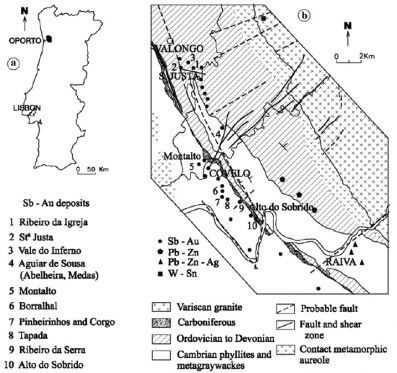MSc Student in Faculty of Sciences of the University of Porto (FCUP) - 2020
Geophysical and Geological Exploration Applied to Sb Mineralizations
The objectives of this thesis are to develop a better understanding of how different geophysical methods respond to antimony mineralizations, as well as use stream sediment data to spatially evaluate these mineralizations.
The geophysical methods that are proposed are Gravity, Magnetic and Electromagnetic. Gravity surveying consists in measuring the variations in the Earth’s gravity, due to the contrast in subsurface rocks’ density. Magnetic surveying measures the variations in the Earth’s Magnetic Field, due to varying magnetic properties in subsurface rocks, such as magnetic susceptibility. The electromagnetic surveying method applied is the VLF (Very Low Frequency), which uses low frequency waves (ranging from 15,0 to 30,0 kHz) that are continuously transmitted by several stations around the world. These waves generate eddy currents on conductive bodies in the subsurface, which then produce a secondary magnetic field that will be measured.
With the data obtained through the surveying, 2D and 3D modelling will be accomplished, and will be used to augment the knowledge of how each method reacts to this type of mineralizations.
The stream sediment data will be analysed, using a SIG software, to create drainage basins for each sample. With this, a spatial analysis of the antimony mineralizations will be done, so that it is possible to understand the correlation between the mineralizations and the different lithologies existing in the area.
These methods are intended to be applied to different areas in Portugal, where antimony mineralizations are known. Starting with the Dúrico-Beirão Mining District (figure 1), in northern Portugal, to afterwards advance to other areas, such as, Castelo Branco and Trás-os-Montes.

Ana Carvalho, MSc Student in Faculty of Sciences of the University of Porto (FCUP)
Ana Carvalho, MSc Student in Faculty of Sciences of the University of Porto (FCUP), currently working on the thesis for the completion of my Master’s Degree in Geology, as part of the AUREOLE project.
Completed my Bachelor’s in Geology in 2018, also at FCUP. My last project done for the bachelor’s degree involved the Geological and Structural characterization of the NE side of Vila Nova de Gaia, Portugal, through the creation of geological profiles from data obtained in the field.
I had the opportunity of working on an extracurricular project that had the objective of collecting different mineral resources samples not available in Portugal from mining companies around the world to create a box of samples that is currently being used in geological resources classes at the university. For each of the samples obtained was create a profile with their occurrences, applications, as well as some history about them.
During my studies I was able to learn about the different areas of geology, but my main pursuits are in geophysical and geological exploration, as well as geological resources. I intend to learn different types of geophysical and geological methods that can be applied to various types of explorations. As someone who likes working on a computer, I really like to be able to use different types of software for the treatment of geological and geophysical data obtained in the field, whether the software is for spatial analysis or 2D and 3D modelling, e.g. ArcGIS or Geomodeller. I aim to learn how to work on different software, so I can be able to answer the demands of different projects.


